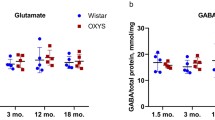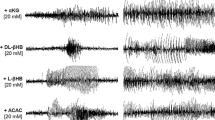Abstract
This study investigated the effects of aging on the actions of a specific glutamate reuptake blocker, L-trans-pyrrolidine-2, 4-dicarboxylic acid (PDC), in extracellular glutamate and glutamine in striatum of the awake rat. Microdialysis experiments were performed on young (2–3 months), middle-aged (12–14 months), aged (27–32 months) and very aged (37 months) male Wistar rats. Local infusion of PDC (1–4 mM) in striatum increased the dialysate concentration of glutamate and decreased dialysate concentration of glutamine in all the age-groups. In young rats, decreases of dialysate glutamine were correlated with increases of dialysate glutamate. The same profile glutamine/glutamate as in young rats was found in middle-aged, aged and very aged rats, which suggests that the action of glutamate on the glutamate-glutamine cycle in striatum of the awake rat is not modified as a consequence of aging. We also found a significant correlation between the increases of glutamate produced by PDC and the basal dialysate concentration of glutamine, a relationship that did show a significant change with age. Although the significance of this latter finding remains to be elucidated, it may be important to understand the changes in glutamate-glutamine cycle during aging.
Similar content being viewed by others
References
Bradford, H. F., Ward, H. K., and Thomas, A. J. 1978. Glutamine: a major substrate for nerve endings. J. Neurochem. 30: 1453–1459.
Fonnum, F. 1993. Regulation of the synthesis of the transmitter glutamate pool. Prog. Biophys. Molec. Biol. 60: 47–57.
Bowyer, J. F., Lipe, G. W., Matthews, J. C., Scallet, A. C., and Davies, D. L. 1995. Comparison of glutamine-enhanced glutamate release from slices and primary cultures of rat brain. Ann. NY Acad. Sci. 765: 98–99.
Paulsen, R. E., Contestabile, A., Villani, L., and Fonnum, F. 1987. An in vivo model for studying function of brain tissue temporatily devoid of glial cell metabolism: the use of fluorocitrate. J. Neurochem. 48: 1377–1385.
Norenberg, M. D. and Martinez-Hernández, A. 1979. Fine structural localization of glutamine synthetase in astrocytes of rat brain. Brain Res. 161: 303–310.
Schousboe, A., Westergaard, N., Sonnewald, U., Petersen, S. B., Yu, A. C. H., and Hertz, L. 1992. Regulatory role of astrocytes for neuronal biosynthesis and homeostasis of glutamate and GABA. Pages 199–211, in Yu, A. C. H., Hertz, L., Norenberg, M. D., Syková, E., and Waxman, S. G. (eds.), Progress in barin research. Vol. 94. Neuronal-astrocytic interactions. Elsevier, Amsterdam.
Westergaard, N., Sonnewald, U., and Schousboe, A. 1995. Metabolic trafficking between neurons and astrocytes; the glutamate/glutamine cycle revisited. Dev. Neurosci. 17: 203–211.
Rothstein, J. D., Dykes-hoberg, M., Pardo, C. A., Bristol, L. A., Jin, L., Kuncl, R. W., Kanai, Y., Hediger, M. A., Wang, Y., Schielke, J. P., and Welty, D. F. 1996. Knockout of glutamate transporters reveals a major role for astroglial transport in excitotoxicity and clearance of glutamate. Neuron 16: 675–686.
Pfrieger, F. W. and Barres, B. A. 1996. New views on synapseglia interactions. Curr. Opin. Neurobiol. 6: 615–621.
Muñoz, M. D., Herreras, O., Herranz, A. S., Solis, J. M., Martin del Rio, R., and Lerma, J. 1987. Effects of dihydrokainic acid of extracellular amino acids and neuronal excitability in the in vivo rat hippocampus. Neuropharmacology 26: 1–8.
Fallgren, A. B. and Paulsen, R. E. 1996. A microdialysis study in rat brain of dihydrokainate, a glutamate uptake inhibitor. Neurochem. Res. 21: 19–25.
Massieu, L., Morales-Villagrán, A., and Tapia, R. 1995. Accumulation of extracellular glutamate by inhibition of its uptake is not sufficient for inducing neuronal damage: an in vivo microdialysis study. J. Neurochem. 64: 2262–2272.
Segovia, G., Del Arco, A., and Mora, F. 1999. Role of glutamate receptors and glutamate transporters in the regulation of the glutamate-glutamine cycle in the awake rat. Neurochem. Res. 24: 779–783.
Terry, R. D. 1986. Interrelations among the lesions of normal and abnormal aging of the brain. Pages 41–48. In Swaab, D. F., Fliers, E., Mirmiran, M., Van Gool, W. A., and Van Haaren, F. (eds.), Aging of the brain and Alzheimer's disease. Progress in brain research. Volume 70. Elsevier, Amsterdam.
Vásquez, M. T., Prados, J., Puerta, A. J., and Mora, F. 1992. Increase of astrocyte population in the medial prefrontal cortex of the rat during aging. Eur. J. Neurosci. Supp. 5: 100
Finch, C. E. and Morgan, D. G. 1990. RNA and protein metabolism in the aging brain. Ann. Rev. Neurosci. 13: 75–87.
O'Callaghan, J. P. and Miller, D. B. 1991. The concentration of glial fibrillary acidic protein increases with age in the mouse and rat brain. Neurobiol. Aging 12: 171–174.
David, J. F., Ghozali, F., Bianco, C. F., Wattez, A., Delaine, S., Boniface, B., Di Menza, C., and Delacourte, A. 1997. Glial reaction in the hippocampal formation is highly correlated with aging in human brain. Neurosci. Lett. 235: 53–56.
Danh, H. C., Strolin Benedetti, M., and Dostert, P. 1985. Agerelated changes in glutamine synthetase activity of rat brain, liver and heart. Gerontology 31: 95–100.
Trabucchi, M., Spano, P. F., Govoni, S., Riccardi, F., and Bosio, A. 1982. Dopaminergic function during aging in rat brain. Pages 195–202, in Giacobini, E., Filogamo, G., Giacobini, G., and Vernadakis, A. (eds.), The aging brain: cellular and molecular mechanisms of aging in the central nervous system. Raven Press, New York.
Wallace, D. R. and Dawson, R. 1993. Regional differences in glutamine activation by phosphate and calcium in rat brain: impairment in aged rats and implications for regional glutaminase isozymes. Neurochem. Res. 18: 1271–1279.
Wallace, D. R. and Dawson, R., Jr. 1994. Assessment of regional phosphate-activate glutaminase (PAG) activity and kinetics in adult and aged Fischer-344 rats. Age 17: 59–63.
Segovia, G., Porras, A., and Mora, F. 1997. Effects of 4-aminopyridine on extracellular concentrations of glutamate in striatum of the freely moving rat. Neurochem. Res. 22: 1491–1497.
Konig, J. R. F. and Klippel, R. A. 1967. The rat brain. R. E. Krieger Publishing Co., New York.
Segovia, G., Del Arco, A., and Mora, F. 1997. Endogenous glutamate increases extracellular concentrations of dopamine, GABA, and taurine through NMDA and AMPA/kainate receptors in striatum of the freely moving rat: a microdialysis study. J. Neurochem. 69: 1476–1483.
Farinelli, E. S. and Nicklas, W. J. 1992. Glutamate metabolism in rat cortical astrocyte cultures. J. Neurochem. 58: 1905–1915.
Waniewski, R. A. and Martin, D. L. 1986. Exogenous glutamate is metabolized to glutamine and exported by rat primary astrocyte cultures. J. Neurochem. 47: 304–313.
Krespan, B., Berl, S., and Nicklas, W. J. 1982. Alteration in neuronal-glial metabolism of glutamate by the neurotoxin kainic acid. J. Neurochem. 38: 509–518.
Segovia, G. and Mora, F. 1998. Role of nitric oxide in modulating the release of dopamine, glutamate, and GABA in striatum of the freely moving rat. Brain Res. Bull. 45: 275–279.
Waldmeier, P. C., Wicki, P., and Feldtrauer, J. J. 1993. Release of endogenous glutamate from rat cortical slices in presence of the glutamate uptake inhibitor L-trans-pyrrolidine-2,4-dicarboxylic acid. Naunyn-Schmiedeberg's Arch. Pharmacol. 384: 478–485.
Volterra, A., Bezzi, P., Rizzini, B. L., Trotti, D., Uilensvamg, K., Danbolt, N. C., and Racagni, G. 1996. The competitive transport inhibitor L-trans-pyrrolidine-2,4-dicarboxylate triggers excitotoxicity in rat cortical neuron-astrocyte co-cultures via glutamate release rather than uptake inhibition. Eur. J. Neurosci. 8: 2019–2028.
Rauen, T., Jeserich, G., Danbolt, N. C., and Kanner, B. I. 1992. Comparative analysis of sodium-dependent L-glutamate transport of synaptosomal and astroglial membrane vesicles from mouse cortex. FEBS Lett. 312: 15–20.
Author information
Authors and Affiliations
Rights and permissions
About this article
Cite this article
Segovia, G., Del Arco, A., Prieto, L. et al. Glutamate-Glutamine Cycle and Aging in Striatum of the Awake Rat: Effects of a Glutamate Transporter Blocker. Neurochem Res 26, 37–41 (2001). https://doi.org/10.1023/A:1007624531077
Issue Date:
DOI: https://doi.org/10.1023/A:1007624531077




